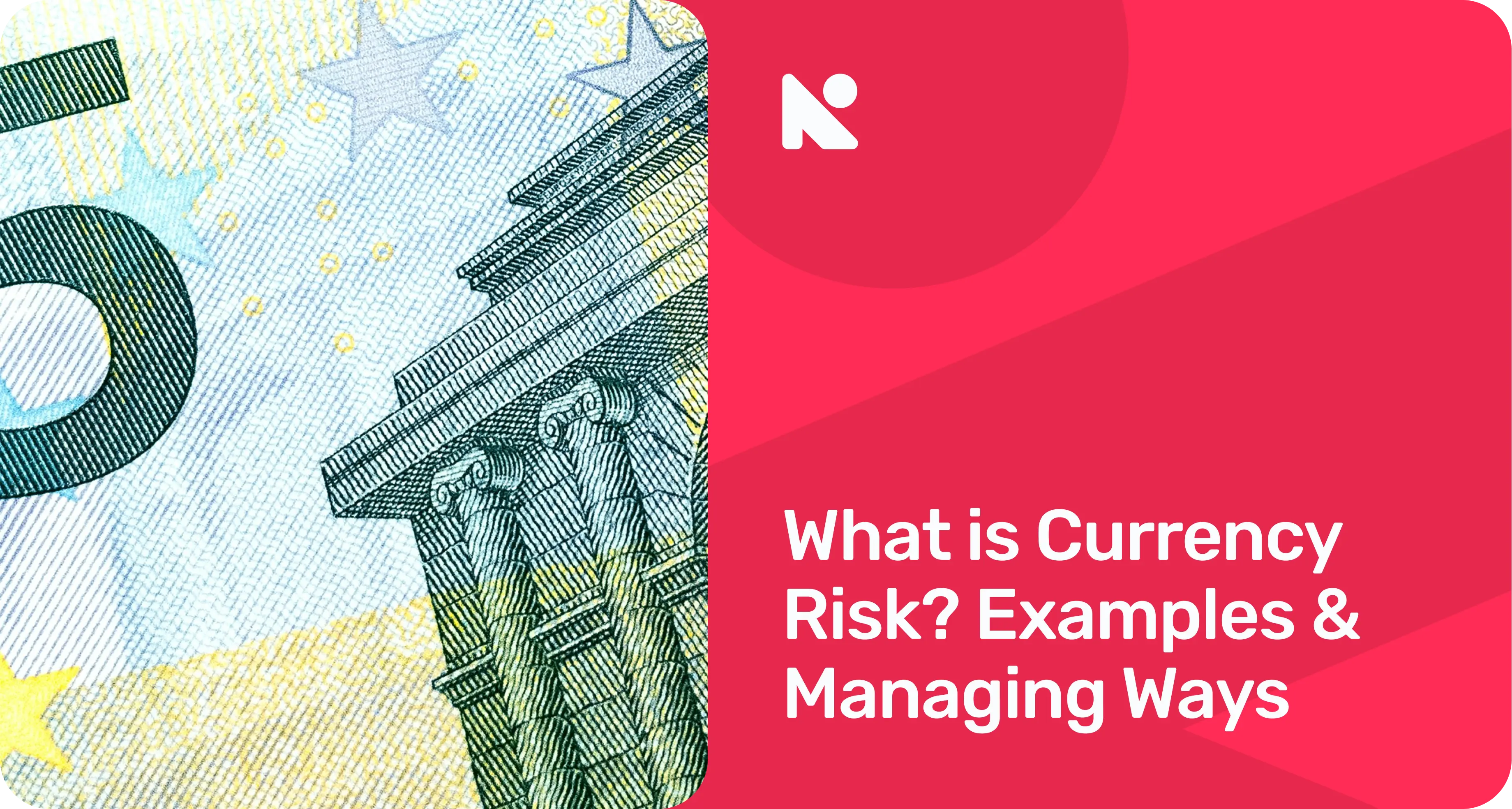What is Currency Risk? Examples & Managing Ways [Guide]
Ever wondered why your international vacation suddenly feels more expensive? Or why an overseas investment might not perform as expected? Currency risk, also known as exchange rate risk, might be the reason. This article dives deep into everything you need to know about what is currency risk, its sneaky impacts, and effective strategies to keep it from ruining your financial plans.

What is currency risk?
Currency risk, also known as foreign exchange (forex) risk, refers to the potential for financial loss arising from movements in exchange rates between different currencies. When you deal in a currency other than your own, the value of your assets and the profitability of your transactions become hostage to these fluctuations. Currency risk, also known as foreign exchange (forex) risk, is the ever-present threat of financial loss lurking in the shadows of international transactions. It arises from the dynamic nature of exchange rates, the constantly shifting value of one currency compared to another.
Imagine you’re a small business owner in Canada who imports handcrafted jewellery from Thailand. You agree on a price and place your order when the exchange rate is favourable. However, by the time your shipment arrives and payment is due, the Thai baht could have weakened against the Canadian dollar. This seemingly minor fluctuation translates into a higher cost for your goods, potentially eating into your profit margin or forcing you to raise prices unexpectedly.
This is the essence of currency risk – the unpredictable movement of exchange rates impacting the value of your foreign assets, the profitability of your international transactions, and, ultimately, your financial bottom line.
Types of currency risk
Currency risk isn’t a one-size-fits-all threat. It manifests in various forms, each with its own set of challenges. Here are some of the types of currency risks:
I. Transaction risk
Transaction risk lurks in the shadows of everyday international transactions. It arises whenever there is a time gap between agreeing on a price in a foreign currency and the actual settlement of the payment.
Imagine you’re booking a dream vacation to Europe and reserving a hotel room months in advance. You lock in the price in euros based on the current exchange rate. However, by the time your trip arrives and you pay for your stay, the euro might have strengthened against your home currency. This unexpected fluctuation translates into a higher final bill, eating into your travel budget. Transaction risk is a common concern for businesses that import goods or services, as well as for individuals who travel or make international purchases.
II. Translation risk
This type of currency risk plagues companies with international operations. It arises from the need to translate the financial statements of subsidiaries operating in different currencies into the parent company’s home currency. Fluctuations in exchange rates can distort the company’s overall financial picture during this translation process.
III. Economic risk
Economic risk refers to the broader impact of currency movements on a company’s competitiveness and profitability in the global market. It’s a long-term threat that can significantly affect a company’s overall financial health. Economic risk is a strategic concern for businesses that operate internationally, as it requires them to consider the long-term impact of currency fluctuations on their global market position.
Causes of currency risk
The difference in exchange rates isn’t random. Several key factors can trigger currency fluctuations, and understanding these culprits is crucial for anticipating and managing currency risk. Here’s a closer look at the main causes:
Political instability. Political turmoil, social unrest, or unpredictable policy changes within a country can erode investor confidence in its currency. This lack of confidence can lead to investors selling off their holdings of that currency, causing its value to weaken. Imagine a major corruption scandal erupts in a country known for oil exports. Investors, worried about economic instability, might pull out their investments, leading to a decline in the value of that country’s currency.
Economic events. The health of a nation’s economy significantly impacts its currency’s value. Factors like interest rate changes, inflation, and economic growth all play a role. For example, a country with rising interest rates might see its currency strengthen as investors are drawn to the higher returns offered by its bonds. Conversely, a country experiencing high inflation might see its currency weaken as the purchasing power of its money decreases.
Changes in market sentiment. Investor confidence and risk perception can cause rapid and sometimes unpredictable currency movements. Global economic slowdowns can trigger a “flight to safety,” where investors seek refuge in established currencies like the Swiss franc or Japanese yen. This sudden shift in demand can cause these safe-haven currencies to appreciate in value. Conversely, positive economic news or a breakthrough in trade negotiations might boost investor confidence in a particular region, leading to an appreciation of its currencies.
Also, beyond the major players, several other factors can influence currency fluctuations. These include natural disasters, changes in commodity prices (like oil), and central bank interventions. While these events might have a less pronounced impact compared to the ones mentioned above, they can still contribute to currency volatility.
By understanding these causes, you can gain valuable insights into potential currency movements and develop strategies to mitigate the risks they pose to your international financial activities.

Implications of currency risk
Currency risk isn’t just a theoretical concept. It can have some real and sometimes significant consequences for individuals and businesses alike. Here’s a closer look at the implications of currency risk:
1. Reduced investment returns
The unfavourable exchange rate could potentially deter businesses from making investments due to a weakened currency. Currency fluctuation can also eat away at potential profits, turning a seemingly sound investment into a less attractive proposition.
2. Increased import costs
Businesses that rely on imported materials or finished goods face the brunt of a weakening domestic currency. The cost of those imports increases, squeezing profit margins and potentially forcing them to raise prices for their own products or services. This can lead to a domino effect, impacting consumer spending and potentially hindering economic growth.
3. Eroded export competitiveness
A strong domestic currency can make a company’s exports more expensive on the global market. This can make them less attractive to foreign buyers, leading to a decline in export sales and potentially harming the company’s overall profitability. Imagine a US-based manufacturer with a strong dollar. Their products become relatively more expensive compared to competitors in other countries, making it harder to secure export deals.
4. Unexpected travel expenses
For individuals planning international travel, currency risk can translate into unexpected expenses. Fluctuations can lead to higher costs for hotels, transportation, and other travel necessities, potentially derailing your travel budget. Imagine booking a vacation to Europe when the euro is weak against your currency. If the euro strengthens before your trip, you might end up spending more than anticipated.
5. Unforeseen business losses
Businesses engaged in international trade are particularly vulnerable to currency risk. Unfavorable exchange rates can lead to unexpected losses on transactions, impacting their cash flow and bottom line. Imagine a company signs a contract to import goods from Japan with a fixed price in yen. If the yen weakens significantly before payment is due, the company faces a potential loss due to the currency fluctuation.
These are just some of the potential implications of currency risk. By understanding these consequences, you can make informed decisions when engaging in international financial activities, be it investing, travelling, or conducting business abroad.
Examples of currency risk: Witnessing the impact
Understanding currency risk in the abstract is one thing, but seeing it in action helps solidify its impact. Here are a couple of real-world examples:
Scenario 1: An American investor purchases shares in a fast-growing Brazilian tech company. The company thrives, but the Brazilian real weakens significantly against the US dollar. Despite the company’s strong performance, investor sees their returns eroded due to the unfavourable exchange rate.
Scenario 2: A European clothing manufacturer imports cotton from Egypt. The euro strengthens considerably against the Egyptian pound, and the cost of imported cotton increases, forcing the manufacturer to raise clothing prices or face reduced profits.
These examples showcase how currency fluctuations can impact both investors and businesses, highlighting the importance of managing currency risk.
Related Article: Why Do Companies Go Global – Native Teams

Strategies for managing currency risk: Arming yourself for the fluctuations
Fortunately, you don’t have to be a passive victim of currency fluctuations. Here are some effective strategies to mitigate currency risk and protect your financial well-being:
1. Natural hedging
Natural hedging involves structuring your business operations or investments to benefit from potential currency movements. For example, a US company with a subsidiary in Europe might choose to source materials from another European country if the euro weakens significantly against the dollar. This helps offset potential losses from the stronger euro.
2. Financial derivatives
Financial instruments like options contracts and currency futures can be used to lock in exchange rates at a specific point in time. This provides a layer of protection against unfavourable fluctuations. Imagine a company has a contract to pay euros in three months. By purchasing euro futures, they can lock in the exchange rate today, shielding themselves from potential euro appreciation.
3. Diversification
Spreading your investments across different currencies and asset classes can minimise the impact of currency swings in any single market. By not putting all your eggs in one basket, you lessen the potential damage caused by currency fluctuations in a particular region.
4. Dynamic and passive currency hedging
These are more advanced strategies. Dynamic hedging involves actively managing your currency exposure based on market forecasts. Passive currency hedging involves a buy-and-hold approach with a diversified currency portfolio, aiming to benefit from long-term currency trends. Both require a deeper understanding of the foreign exchange market and might be best suited for experienced investors or businesses with professional financial advisors.
What is the safest currency?
Unfortunately, there’s no single “safest” currency. Global economic conditions are constantly evolving, and what’s considered stable today might not be tomorrow. However, currencies from countries with strong economies, political stability, and a history of low inflation tend to be less volatile.
Examples of some of the current strong currencies include the US dollar, Swiss franc, and Japanese yen.

How do businesses protect against currency risk?
Businesses can utilise a combination of the strategies mentioned above. Additionally, they can negotiate contracts with currency clauses that specify payment terms or explore insurance products designed to mitigate currency risk. Careful monitoring of exchange rates and staying informed about global economic developments are also crucial for businesses operating in the international arena.
In conclusion, currency risk is an ever-present reality in today’s globalised world. By understanding its definition, types, causes, and potential impacts, you can develop effective strategies to manage it and protect your financial interests. Remember, knowledge is power. With the right tools and strategies, you can navigate the ever-changing currency landscape with confidence.
